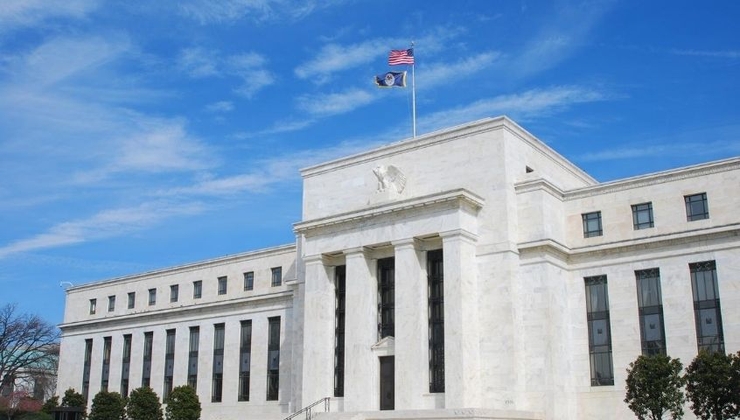差价合约(CFD)是复杂的工具,由于杠杆作用,存在快速亏损的高风险。80% 的散户投资者在于该提供商进行差价合约交易时账户亏损。 您应该考虑自己是否了解差价合约的原理,以及是否有承受资金损失的高风险的能力。
Ultimately we have four possible election day outcomes: a red redux, a blue wave, a divided government, or a contested/delayed result. We’ve seen recently how problematic a divided government can be, with house democrats and republicans unable to agree on a fiscal relief package. Ultimately a government with full control of Congress is the bull case for markets and a blue wave may be even more bullish than republican control - as the democrats have made it clear they are willing to blow the deficit and spend big.
So six weeks out from the election, how are markets positioned? We have the US dollar index (USDX) at a two-year low, mostly due to an ever-dovish Federal Reserve, but it’s a trend that could continue into the election. Gold (XAUUSD) has consolidated between 1920 and 1980 after setting a series of record highs in August. The precious metal is moving sideways, waiting for a trigger to break out of the range. US stocks are strong despite last week’s rotation out of tech and US treasury yields remain low, with real rates slowly pushing deeper into negatives.
Quite possibly the most important forex pair to watch as the election nears is USDJPY. The forex pair has a track record of sensitivity to US elections, typically falling in the lead up on safe haven flows and risk hedging, then unwinding once the dust settles. Start forex trading today.
On the weekly chart, we find price in a descending channel that’s so far held for 14 weeks. The steady fall reflects broader USD weakness but also supports the trend of JPY strength ahead of election day. The USD may also simply struggle to find buyers until an election outcome is known. So if the USDJPY bear channel holds as the election approaches, it may be the newsflow on election day that provides the catalyst for a break higher or lower.
Weekly chart: USDJPY. Support at 105.30. Chart source data: Metaquotes MT5.
Nearer term, I’m watching for a break of 105.30 support on a closing basis to encourage the next move lower, with a target near 104.22 - still within the descending channel.
S&P 500 - Do US stocks hold the clue?
US stocks have defied odds and erased pandemic losses. The NAS100 started setting new record highs in June; and the S&P 500 (US500) in August.
There’s a reason Trump emphasises the NAS and the S&P time and time again: a positive stock market is typically good news for the incumbent. In fact, 90% of the time since 1928, the incumbent has won a second term when the US500 has been positive three months out from the election. The president has gone as far as pushing the idea that a democratic administration would hurt the stock market, and although there’s no real reason to justify that, it shows Trump’s awareness the stock market can be an election winner.
Daily chart: US500. Chart source data: Metaquotes MT5.
Despite the recent tech sell-off and rotation into underperforming stocks, the US500 remains strong and has so far found support in the 50-EMA (purple line). Yet price is struggling to push back above that 3400 handle, which represents the pre-pandemic highs. If stocks start to sour - a daily close below the 50-EMA would concern me - so too could Trump’s re-election odds.
So are we looking at an eventual re-test of the Feb-Sep trendline (black)? Or is this the start of something sinister? I’ll let the technicals play out before I take a view on this one.
Election scenarios
Strong US stocks and a weak US dollar, for now at least. So how could the possible US election outcomes move these markets?
Trump and a red redux
Cast your mind back to 2016 and markets were nervous about what a Trump presidency would mean for markets. They quickly found their mojo again though when Trump started sounding “presidential” and his pro-business stance was better understood.
A Trump win in November, with a majority in Congress, is a pretty bullish case for markets. It’s the status quo ticket as markets know what to expect - and US-China trade war aside, Trumpian policy has been accommodative for business and markets.
But as business-friendly as the administration has been, what markets really need is growth in order to climb out of the covid recession. While the 2017 corporate tax cuts were mostly deficit financed and fiscal support this year record in size, house republicans are not as willing to spend as big as democrats are.
Polls also suggest a red wave is unlikely. While Trump could win the White House again, the democrats will likely maintain their house majority, which will cause headaches for new legislation and recovery packages.
Biden and a blue wave
Contrary to conventional beliefs, a blue wave may just be the most bullish case for the USD and US stocks this election. Sure the Democratic party is generally perceived as less friendly to Wall Street and Biden has talked about a corporate tax hike, but markets are less punishing of currencies whose governments run ever-larger deficits these days - and the democrats are ready to spend big.
The Biden-Harris ticket has proposed a $2tn infrastructure package, mostly deficit financed, and recent house negotiations show the democrats willing to spend larger than the GOP. The Fed can’t drive higher inflation by itself, and central banks the world over have emphasised the need for fiscal spending to lead the recovery, so the 2020 democratic ticket may just be the bullish case for growth and US outperformance.
The infrastructure spend would create jobs, support business, and hopefully create upward pressure on wages and prices. While energy and financial stocks may struggle under Dem policies, a strong case for growth would boost the consumer staples and discretionaries sectors. And as US economics start to outperform the rest of the world, capital starts flowing into the US, boosting the USD and US stocks.
If the outcome on 3 November is an uncontestable blue wave, we may still see that typical market panic, however I’d expect it to be short-lived and see a buying opportunity.
Divided government
The US government is currently divided, with a republican White House and democratic house. We’ve recently seen the stalemates such a setup can cause when trying to pass crucial fiscal packages.
Under a divided government, less can be achieved and crisis responses can slow - this is particularly worrying when trying to climb out of an economic crisis as we are now.
So while a mixed administration could prevent a Biden administration lifting the corporate tax rate and cracking down on the fossil fuel industry, it could prevent stimulus packages and hinder the recovery, hurting the USD and US stock markets with stimulus plans less likely to be rolled out.
Contested election
Trump has sown the seeds of mail-in voter fraud or a rigged election, hinting that he may not give up power so easily if the results are close. Slower counting of mail-in votes may also see Republicans claiming victory on early results before mail-in votes tilt the outcome blue. This is all a recipe for market volatility.
Whether the result is delayed due to the expected uptake in mail-in ballots, or outright contested because the results are close, the outlook becomes much less certain. Recent civil unrest also suggests that certain results could face mass protests.
There’s a lot to consider ahead of 3 November, and a lot could change in the few weeks left ahead of election day. So how will you trade the 2020 US election?
Related articles
做好交易准备了吗?
只需少量入金便可随时开始交易。我们简单的申请流程仅需几分钟便可完成申请。
此处提供的材料并未按照旨在促进投资研究独立性的法律要求准备,因此被视为市场沟通之用途。虽然在传播投资研究之前不受任何禁止交易的限制,但我们不会在将其提供给我们的客户之前寻求利用任何优势。
Pepperstone 并不表示此处提供的材料是准确、最新或完整的,因此不应依赖于此。该信息,无论是否来自第三方,都不应被视为推荐;或买卖要约;或征求购买或出售任何证券、金融产品或工具的要约;或参与任何特定的交易策略。它没有考虑读者的财务状况或投资目标。我们建议此内容的任何读者寻求自己的建议。未经 Pepperstone 批准,不得复制或重新分发此信息。


